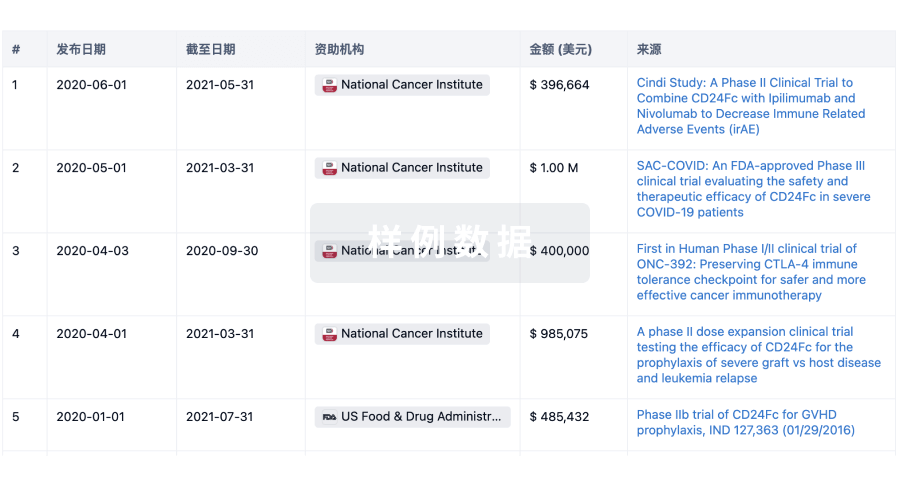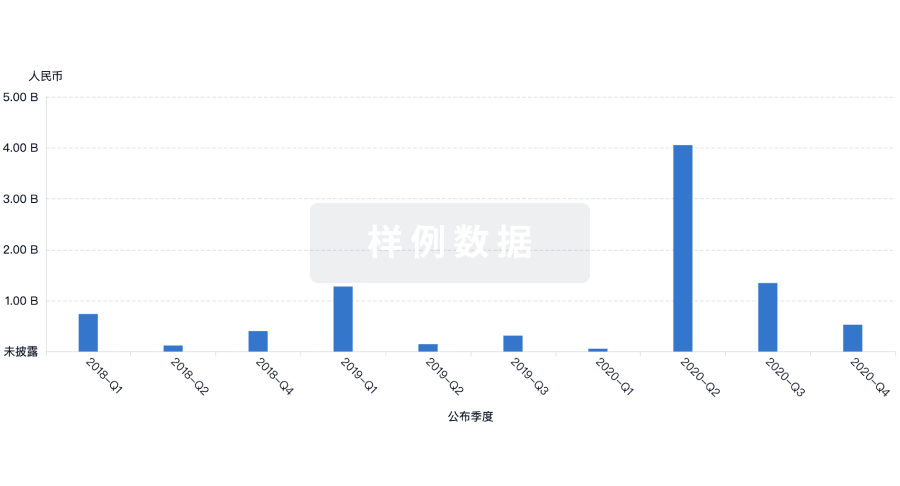预约演示
更新于:2025-05-07

University of Aarhus
更新于:2025-05-07
概览
标签
神经系统疾病
感染
免疫系统疾病
融合蛋白
小分子化药
三特异性抗体
疾病领域得分
一眼洞穿机构专注的疾病领域
暂无数据
技术平台
公司药物应用最多的技术
暂无数据
靶点
公司最常开发的靶点
暂无数据
| 排名前五的药物类型 | 数量 |
|---|---|
| 小分子化药 | 2 |
| 融合蛋白 | 2 |
| 重组多肽 | 1 |
| 三特异性抗体 | 1 |
| ASO | 1 |
| 排名前五的靶点 | 数量 |
|---|---|
| SORL1 | 2 |
| IgE(免疫球蛋白E) | 1 |
| C3b(补体C3b) | 1 |
| PAPPA1 | 1 |
| Bcl-2(细胞凋亡调控因子Bcl-2) | 1 |
关联
14
项与 University of Aarhus 相关的药物靶点 |
作用机制 Bcl-2抑制剂 |
在研机构 |
原研机构 |
非在研适应症 |
最高研发阶段批准上市 |
首次获批国家/地区 美国 |
首次获批日期2016-04-11 |
靶点 |
作用机制 VDR激动剂 |
在研机构 |
最高研发阶段批准上市 |
首次获批国家/地区 加拿大 |
首次获批日期1985-01-01 |
靶点 |
作用机制 TLR9激动剂 [+1] |
在研机构 |
原研机构 |
最高研发阶段临床1期 |
首次获批国家/地区- |
首次获批日期- |
1,473
项与 University of Aarhus 相关的临床试验NCT06924164
Snappy Hip Trial: A Randomized Crossover Trial Comparing the Clinical and Cost-effectiveness of Progressive Resistance Training Compared to Usual Care on Pain for Adults With External Snapping Hip
External snapping hip is characterised by an audible and painful snap during hip movement among physical active people around 15-40 years old. Progressive resistance training has been suggested as a new potential treatment path in treating patients with external snapping hip. We conducted a feasibility study and found that patients reported less pain and improved their physical function, quality of life and muscle strength after 12 weeks of progressive resistance training. The overall aim of the project is to compare hip pain in patients with external snapping hip treated with progressive resistance training to a wait-and-see approach, in a randomised controlled trial. This study has the potential to establish a new and specific treatment option for patients with external snapping hip, to be used nationally and internationally.
开始日期2025-07-01 |
申办/合作机构 |
NCT06921967
A Comparison of Ocular Health and Visual Quality With Corneal and Scleral Rigid Gas Permeable Lenses in Keratoconus Patients
This study aims to compare the ocular health and visual quality of corneal rigid gas permeable lenses (CRGPL) and scleral rigid gas permeable lenses (SRGPL) for patients with keratoconus in a crossover clinical trial. The study will analyze subjective and objective outcomes, including best corrected visual acuity, contrast sensitivity, higher-order aberrations and subjective perception of visual function and comfort. It will also investigate the impact of both lens types on the health of the ocular surface, including evaluation of corneal, conjunctival, and scleral tissues, and tear film. Only one randomized controlled trial has compared the effect of CRGPL and SRGPL wear for patients with an ectatic corneal disorder. With the increasing popularity of SRGPL, examining the differences in efficacy, safety, and patient-reported outcomes between the two types of lenses is increasingly relevant.
开始日期2025-06-01 |
申办/合作机构  University of Aarhus University of Aarhus [+1] |
NCT06950073
CUratively Intended Thoracic REirradiation: An Observational Study of High-dose Reirradiation of Thoracic Tumours: A Multicentre Prospective Registration Protocol
The number of long-term lung cancer (LC) survivors increases, however many patients are diagnosed with recurrent or new thoracic cancers. High-dose reirradiation (reRT) is promising but associated with high severe toxicity rates. Existing studies are small lacking high-quality data, with no clear correlation between toxicity risk and delivered radiotherapy (RT) dose.
This Danish multicentre prospective cohort study aims to provide a framework for collecting radiotherapy-related toxicity data, loco-regional control, and overall survival data for patients with thoracic cancer undergoing reirradiation; with the ultimate aim of providing safe reirradiation to more patients.
As a secondary aim, guidelines for dose accumulation and provisional constraints for the organs at risk will be used to establish a uniform treatment strategy for reirradiation.
The CURE Lung trial will provide high-impact, globally missing data. This project will ensure full utilization of and learning from the trial, adding SDM, PROMs, and modality referral to the trial. It will model the correlation between toxicity burden and doses, enabling individualized reRT with optimized dose prescription based on toxicity risk and patient preferences, and assisting in the decision-making on the prescription dose and optimal modality. This will ensure safe reRT for the increasing number of long-term LC survivors.
This Danish multicentre prospective cohort study aims to provide a framework for collecting radiotherapy-related toxicity data, loco-regional control, and overall survival data for patients with thoracic cancer undergoing reirradiation; with the ultimate aim of providing safe reirradiation to more patients.
As a secondary aim, guidelines for dose accumulation and provisional constraints for the organs at risk will be used to establish a uniform treatment strategy for reirradiation.
The CURE Lung trial will provide high-impact, globally missing data. This project will ensure full utilization of and learning from the trial, adding SDM, PROMs, and modality referral to the trial. It will model the correlation between toxicity burden and doses, enabling individualized reRT with optimized dose prescription based on toxicity risk and patient preferences, and assisting in the decision-making on the prescription dose and optimal modality. This will ensure safe reRT for the increasing number of long-term LC survivors.
开始日期2025-05-01 |
申办/合作机构 |
100 项与 University of Aarhus 相关的临床结果
登录后查看更多信息
0 项与 University of Aarhus 相关的专利(医药)
登录后查看更多信息
75,101
项与 University of Aarhus 相关的文献(医药)2025-05-01·Marine Pollution Bulletin
Enhancing Lagrangian particle tracking using objective Eulerian coherent structures
Article
作者: Quintana-Barranco, Ricardo ; Argáez, Carlos ; Appendini, Christian M ; Duran, Rodrigo ; Allende-Arandía, María Eugenia
2025-05-01·Urologia Journal
Emerging strategies in tackling antimicrobial resistance in urology: Narrative review and expert opinion
Review
作者: Ceccato, Tommaso ; Ruggera, Lorenzo ; Botti, Simone ; Cai, Tommaso ; Massidda, Orietta ; Brugnolli, Anna ; Tascini, Carlo ; Racanelli, Vito ; Bjerklund Johansen, Truls E ; Lanzafame, Massimiliano
2025-04-17·The Journal of Physical Chemistry A
Local Bond-Stretch Coordinates for Anharmonic Vibrational Computations
Article
作者: Thomsen, Sebastian Riis ; Højlund, Mads Greisen ; Høyer, Nicolai Machholdt ; Christiansen, Ove
136
项与 University of Aarhus 相关的新闻(医药)2025-01-13
MONDAY, Jan. 13, 2025 -- For patients with
type 1 diabetes
with moderate-to-severe gastrointestinal symptoms, fecal microbiota transplantation (FMT) is safe and improves clinical outcomes, according to a study published in the January issue of
eClinicalMedicine
.
Katrine Lundby Høyer, from Aarhus University in Denmark, and colleagues conducted a randomized, double-blind, placebo-controlled pilot trial involving adults with type 1 diabetes and moderate-to-severe gastrointestinal symptoms. Twenty patients were randomly assigned to receive 25 capsules of encapsulated FMT, containing 50 mg of feces, administered in a single dose, or placebo capsules containing glycerol, saline, and food coloring. All patients received a second intervention of FMT.
The researchers observed no difference between the groups in adverse events, with four patients in the FMT group reporting seven adverse events and five patients in the placebo group reporting 19. Diarrhea, bloating, and abdominal pain were the most frequent adverse events. The median Gastrointestinal Symptom Rating Scale-Irritable Bowel Syndrome score was reduced from 58 to 35 among patients who received FMT and from 64 to 56 among patients receiving placebo. There was improvement in the Irritable Bowel Syndrome Impact Scale score, from 108 to 140 with FMT and from 77 to 92 with placebo. There was a decline in the Patient Assessment of Gastrointestinal Symptom Severity Index from a median of 42 to 25 and from 47 to 41 after FMT and placebo, respectively.
"To our knowledge, this study represents the most promising clinical effect of FMT beyond its established efficacy in treating
Clostridium difficile
infection," the authors write.
Several authors disclosed ties to the pharmaceutical and medical device industries.
Abstract/Full Text
Whatever your topic of interest,
subscribe to our newsletters
to get the best of Drugs.com in your inbox.
临床结果微生物疗法临床3期
2025-01-08
Commit Biologics appoints accomplished R&D executive, Dr Janine Schuurman, to its Board of Directors
Former senior vice president of antibody research at Genmab who has co-invented numerous FDA-approved therapeutic antibodies and as well as its DuoBody® bi-specific antibody platform
Brings decades of experience in developing strong pipelines of antibody-based drugs from platforms, growing scientific teams and managing partnerships with Pharma companies
Appointment comes as Commit looks to progress towards drug candidate (DC) nomination in cancer and autoimmune disease in 2025
AARHUS, Denmark, Jan. 8, 2025 /PRNewswire/ -- Commit Biologics ("Commit"), a pioneer in the activation of the complement system to treat cancer and autoimmune disease, today announces the appointment of Janine Schuurman, Ph.D. to its Board of Directors.
Dr Schuurman is a widely recognized scientific leader with over 25 years' experience in antibody research, discovery, and development. She is the co-inventor of several FDA approved drugs, including amivantamab (RYBREVANT® Janssen) and epcoritamab (EPKINLY® Genmab/Abbvie).
Dr Schuurman also played a key role in the development of antibody platform technologies while at Genmab, such as DuoBody® and HexaBody®, and rose to become Senior Vice President, Head of Antibody Research and Development. A renowned speaker at scientific conferences, Dr Schuurman is currently President of The Antibody Society, a highly regarded non-profit supporting antibody-related research and development.
Krishna Polu, MD, Chief Executive Officer of Commit Biologics, said: "Janine brings a wealth of knowledge and experience that will greatly benefit Commit - both in terms of the science of antibody research and development, and in the practical know-how of building teams, pipelines and partnerships that is so essential to achieving drug approvals success. Her experience in developing meaningful therapeutic antibodies and antibody platforms will be invaluable. We look forward to partnering with her and the board to advance Commit's BiCE platform to DC candidate selection in 2025."
Janine Schuurman, PhD, newly appointed Board Member of Commit Biologics,
said: "Commit's BiCE platform, which has the potential to give antibody therapeutics the power to strongly activate the complement system, is an extremely exciting technology. I look forward to helping Commit advance BiCE from platform to pipeline, using all the scientific and operational experience I have gained over the years I have been successfully developing antibody-based drugs."
Dr Schuurman holds a PhD in molecular immunology from the University of Amsterdam.
Commit Biologics is advancing development of its Bispecific Complement Engaging (BiCE™) technology, which is designed to potently activate the complement system – a part of the immune system which has often been overlooked in terms of its therapeutic potential. BiCE uses single domain antibodies that bind to the complement protein C1q, thus directing the complement system in a highly selective way against tumor cells or cells implicated in autoimmune disease.
Dr Schuurman, who previously served as a scientific advisor to Commit, joins its Board of Directors with immediate effect.
About Commit Biologics
Commit Biologics (Commit) is a pioneer in activating the complement system to kill specific target cells, with applications in cancers and autoimmune diseases. Spun out of Aarhus University, and building on more than three decades of research, Commit's Bispecific Complement Engaging (BiCE™) platform can supercharge a conventional monoclonal antibody to activate the complement system more effectively. This is achieved by combining single domain antibodies that engage C1q, the starting point for the complement activation cascade, with an antibody that binds to a cellular target. The modular approach of the BiCE™ technology can be used to develop therapeutics across multiple tumor-associated antigens and immune cell targets. Complement is a largely untapped aspect of the body's natural immune system that leverages both the direct cytolytic activity of complement along with its ability to bridge recruitment and activation of both innate and adaptive immune cells – a new approach to killing cells which can be used in combination or on a standalone basis. Commit is backed by major investors including Bioqube Ventures, Novo Holdings and Korys.
About the complement system
The complement system is part of the body's immune system that has previously been largely untapped therapeutically. The activation of the classical complement pathway, which has a role in health for pathogen defense, begins with the engagement of C1q to antibodies that coat the cell surface and ends with the activation of a cytolytic complement complex directly leading to cell lysis. However, current monoclonal antibodies developed for therapeutic purposes have structural restraints that hinder effective engagement to C1q, thus limiting complement mediated cytotoxicity and other complement mediated effector functions. This, plus the presence of natural cell bound complement inhibitors that are upregulated in cancer, and low target densities, make conventional therapeutic antibodies poor complement activators. Commit's BiCE™ technology was developed to overcome these barriers, to harness the power of the complement system and direct it towards tumor and immune cells for therapeutic applications. Unleashing this power in a highly targeted way with Commit's technology potentially allows for a broad therapeutic index and the development of highly effective treatments.
SOURCE Commit Biologics
WANT YOUR COMPANY'S NEWS FEATURED ON PRNEWSWIRE.COM?
440k+
Newsrooms &
Influencers
9k+
Digital Media
Outlets
270k+
Journalists
Opted In
GET STARTED
高管变更
2024-12-18
NMD Pharma publishes new data on the role of ClC-1 inhibition in Charcot-Marie-Tooth in the Annals of Clinical and Translational Neurology Results from the ESTABLISH1 observational study confirms that neuromuscular junction (NMJ) dysfunction is an underappreciated disease characteristic in patients with Charcot-Marie-Tooth disease (CMT) types 1 and 2 affecting muscle function in patientsAdditionally, results from preclinical studies provide proof-of-mechanism for recovery of muscle function with ClC-1 inhibition using NMD670 in CMT mouse models Aarhus, Denmark, 18 December 2024 – NMD Pharma A/S, a clinical-stage biotech company dedicated to developing novel and improved treatments for patients living with neuromuscular diseases, today published new data in the journal Annals of Clinical and Translational Neurology with collaborators from the Aarhus University Hospital, University of Missouri, The Ohio State University, and Aarhus University. The peer-reviewed paper, entitled ‘Neuromuscular Transmission Deficits in patients with CMT and ClC-1 Inhibition in CMT animal Models,’ provides evidence that targeting the neuromuscular junction (NMJ) with ClC-1 inhibitors, such as NMD670, could enhance muscle function in patients with CMT, a rare neuromuscular disease. Clinical features of CMT include motor signs and symptoms such as muscle weakness, muscle atrophy, and fatigue, as well as sensory deficits that, in combination, cause substantial reduction in quality of life. Preclinical studies have previously implicated NMJ transmission deficits in muscle dysfunction in CMT. This study describes results from ESTABLISH1, an observational clinical study in CMT Type 1 and 2 patients and healthy patients in the US and Denmark, which confirms that patients with CMT, regardless of genotype, have notable NMJ transmission dysfunction that correlates with disease severity. In addition, the paper describes that the treatment of mouse models of CMT Type 1 (CMT1A) and CMT Type 2 (CMT2D) following partial inhibition of ClC-1 chloride channels and the application of nerve-stimulated muscle force, was shown to improve muscle contractile function with the addition of the novel small molecule ClC-1 inhibitor NMD670. W. David Arnold, MD, Principal Investigator who led the international ESTABLISH1 observational study, commented: “With no currently approved therapies to provide a cure or alleviate symptoms, data from the ESTABLISH and preclinical studies represents a significant milestone in the development of a treatment. Here, the data shows that patients with CMT, regardless of genotype, are characterized by notable NMJ transmission dysfunction, and that the level of dysfunction directly correlates with the level of disease severity, further confirming the potential therapeutic value of ClC-1 inhibition to address the muscle weakness and fatigue associated with CMT.” Thomas Holm Pedersen, Chief Executive Officer of NMD Pharma, added: “This data provides further evidence of the crucial role of neuromuscular junction dysfunction in CMT patients. The impaired connectivity between the motor neuron and skeletal muscle at the neuromuscular junction in CMT patients presumably occurs because the axons are in a process of degeneration or are newly formed or forming neuromuscular junctions from axons nearby degenerated connections. It is very promising that NMD670 improves muscle contractile function in animal models of CMT, and we have already started evaluating the effect of NMD670 in a Phase 2 clinical trial which we initiated in November 2024.” The full manuscript is available online through the following link: Neuromuscular transmission deficits in patients with CMT and ClC‐1 inhibition in CMT animal models - Grønnebæk - Annals of Clinical and Translational Neurology - Wiley Online Library On 18 November, NMD Pharma announced that it had dosed the first CMT disease patient in its Phase 2 clinical trial of NMD670. NMD Pharma has three ongoing global clinical trials investigating NMD670 across rare neuromuscular diseases characterized by a high degree of patient impact and need, including a Phase 2 study in adults living with spinal muscular atrophy type 3 and a Phase 2b study in generalized myasthenia gravis patients. Further information on the study can be found here: Study Details | Safety and Efficacy of NMD670 in Adult Patients With Type 1 and Type 2 Charcot-Marie-Tooth Disease | ClinicalTrials.gov Exploring SynapTic ABnormaLitIeS in Hereditary neuropathies -END- Contacts NMD Pharma A/SDan Brennan, SVP Corporate and Commercial StrategyE-mail: contact@nmdpharma.com ICR HealthcareMary-Jane Elliott / Ashley Tapp / Lindsey Neville E-mail: NMDPharma@icrhealthcare.comTel: +44 (0)20
3709 5700 About NMD PharmaNMD Pharma A/S is a clinical-stage biotech company developing a first-in-class platform of small molecule therapies selectively targeting the skeletal muscle chloride ion channel (ClC-1) for the treatment of rare neuromuscular disorders and age-related neuromuscular diseases with high levels of patient unmet. The Company was founded on more than 15 years of muscle physiology research with a focus on regulation of skeletal muscle excitability under physical activity. NMD Pharma has built a world-leading muscle electrophysiology platform leveraging the in-depth know-how of muscle physiology and muscular disorders, small molecule modulators, enabling technologies and tools as well as in vivo pharmacology models for discovering and developing proprietary modulators of neuromuscular function. The Company has built significant clinical and development expertise as its programmes have progressed through the clinic. NMD Pharma has raised ~€155 million from investors including Novo Holdings, Lundbeckfonden BioCapital, INKEF Capital, Roche Venture Fund, and Jeito Capital. Find out more about us online at http://www.nmdpharma.com. About NMD670NMD670 is NMD Pharma’s lead development program. It is a first-in-class small molecule inhibitor of the skeletal muscle specific chloride ion channel 1 (CIC-1). NMD Pharma has demonstrated that CIC-1 inhibition amplifies the muscle’s responsiveness to weak signals, improving neuromuscular transmission and restores skeletal muscle function. This novel treatment approach has resulted in clinical evidence of CIC-1 inhibition in myasthenia gravis and preclinical evidence in spinal muscular atrophy, Charcot-Marie Tooth disease and sarcopenia. NMD670 has also been granted orphan-drug designation by the U.S. FDA for treatment of gMG. About Charcot-Marie-Tooth disease (CMT)CMT encompasses a group of hereditary sensory and motor neuropathies that cause damage to peripheral nerves and their neuromuscular junction. Damage caused by CMT worsens slowly over time and can result in substantial reductions in mobility, independence and quality of life due to muscle weakness, fatigue and atrophy across skeletal muscle groups such as the legs, feet, arms, hands and potentially leading to diaphragm weakness and paralysis. CMT is often broadly grouped into demyelinating (CMT type 1) and axonal (CMT type 2) based on nerve conduction studies, but there are more than 160 subtypes of CMT based on their genetic causes, clinical features and progression patterns. CMT affects approximately 136,000 individuals in the United States and 3.2 million worldwide, with first symptoms typically appearing during adolescence or early adulthood.
临床2期孤儿药
100 项与 University of Aarhus 相关的药物交易
登录后查看更多信息
100 项与 University of Aarhus 相关的转化医学
登录后查看更多信息
组织架构
使用我们的机构树数据加速您的研究。
登录
或

管线布局
2025年11月02日管线快照
管线布局中药物为当前组织机构及其子机构作为药物机构进行统计,早期临床1期并入临床1期,临床1/2期并入临床2期,临床2/3期并入临床3期
药物发现
5
2
临床前
临床2期
1
6
其他
登录后查看更多信息
当前项目
| 药物(靶点) | 适应症 | 全球最高研发状态 |
|---|---|---|
维奈克拉 ( Bcl-2 ) | HIV感染 更多 | 临床2期 |
ML2006a4 | 新型冠状病毒感染 更多 | 临床前 |
Triculamin | 分枝杆菌感染 更多 | 临床前 |
WO2023031309 ( C3b ) | 感染 更多 | 药物发现 |
US20240279666 ( SORL1 ) | 阿尔茨海默症 更多 | 药物发现 |
登录后查看更多信息
药物交易
使用我们的药物交易数据加速您的研究。
登录
或

转化医学
使用我们的转化医学数据加速您的研究。
登录
或

营收
使用 Synapse 探索超过 36 万个组织的财务状况。
登录
或

科研基金(NIH)
访问超过 200 万项资助和基金信息,以提升您的研究之旅。
登录
或

投资
深入了解从初创企业到成熟企业的最新公司投资动态。
登录
或

融资
发掘融资趋势以验证和推进您的投资机会。
登录
或

生物医药百科问答
全新生物医药AI Agent 覆盖科研全链路,让突破性发现快人一步
立即开始免费试用!
智慧芽新药情报库是智慧芽专为生命科学人士构建的基于AI的创新药情报平台,助您全方位提升您的研发与决策效率。
立即开始数据试用!
智慧芽新药库数据也通过智慧芽数据服务平台,以API或者数据包形式对外开放,助您更加充分利用智慧芽新药情报信息。
生物序列数据库
生物药研发创新
免费使用
化学结构数据库
小分子化药研发创新
免费使用




